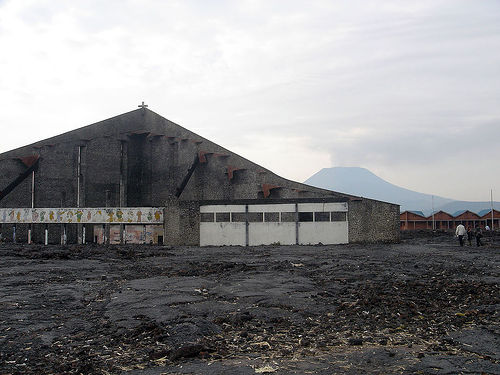In the Shadow of the Volcano: Democracy and Justice in Congo
In the Shadow of the Volcano: Democracy and Justice in Congo
Goma, provincial capital of North Kivu and the second-largest town in eastern Democratic Republic of Congo (DRC), lies at the heart of the world’s most destructive conflict since the Second World War. In the last decade, around three million Congolese have been killed by violence between government and rebel forces from seven African countries and by conflict-related disease and deprivation. Wedged between volcanic Mount Nyiragongo and Lake Kivu, Goma is a moonscape of craggy, black rock. In 2002, Nyiragongo erupted, engulfing parts of Goma in lava and forcing the town’s hundred thousand inhabitants to flee across the nearby border to Rwanda. Many of them soon returned to Goma, where lava still steamed in the streets. The population later rebuilt the town out of the volcanic rock that had destroyed it.

Today, Goma is an equatorial Atlantis, half-submerged in hardened lava. The population lives and works above the lava-line, in the upper stories of buildings damaged by the volcano and new buildings constructed on the surface. The recently-built Mango Airlines branch stands beside the abandoned Congo Airways office, buried to within a few feet of its roof, both surrounded by rusty skeletons of destroyed warehouses. The air is thick with black dust and ash.
Three key developments brought me back to eastern Congo in early 2006 after several years away: rapidly changing patterns of violence in the region, the buildup to Congo’s historic first elections since independence, and new attempts to bring perpetrators of mass crimes to justice. As conflict rages, Congo confronts questions fraught enough during peacetime: Can a highly fragmented state of 250 ethnic groups, with a long history of violence, corruption, and extreme poverty, embrace democracy and create effective political institutions? Can individuals responsible for committing atrocities be held accountable? And can democracy and justice contribute to a stable, vibrant nation in the long term? Given Congo’s strategic importance, bordered by ten countries in the heart of Africa, these are not merely questions for the nation but for the Great Lakes region and the continent as a whole.
Arriving in Goma, I found hundreds of people huddled against the barbed-wire fence around the airport, watching as soldiers from the United Nations Mission in the Democratic Republic of Congo (known by its French acronym, MONUC) loaded three huge cargo planes. MONUC is the largest UN peacekeeping mission ever assembled, with 17,000 soldiers and police officers, operating—in a rarity for a UN mission—under a Chapter VII mandate that permits them to use force to protect civilians and UN staff. I asked one man what was happening on the tarmac. “The pla...
Subscribe now to read the full article
Online OnlyFor just $19.95 a year, get access to new issues and decades' worth of archives on our site.
|
Print + OnlineFor $35 a year, get new issues delivered to your door and access to our full online archives.
|






